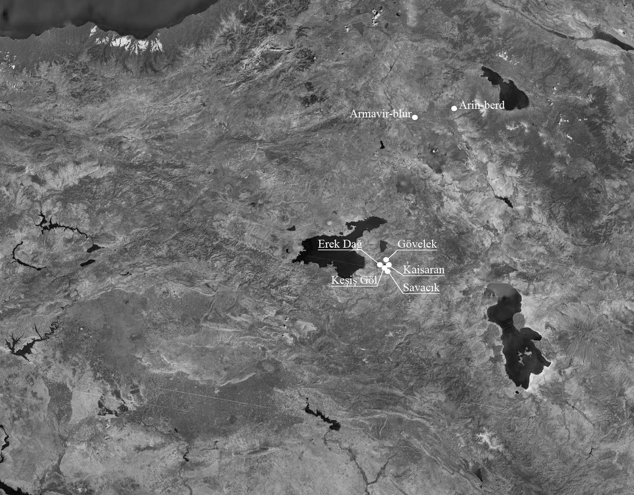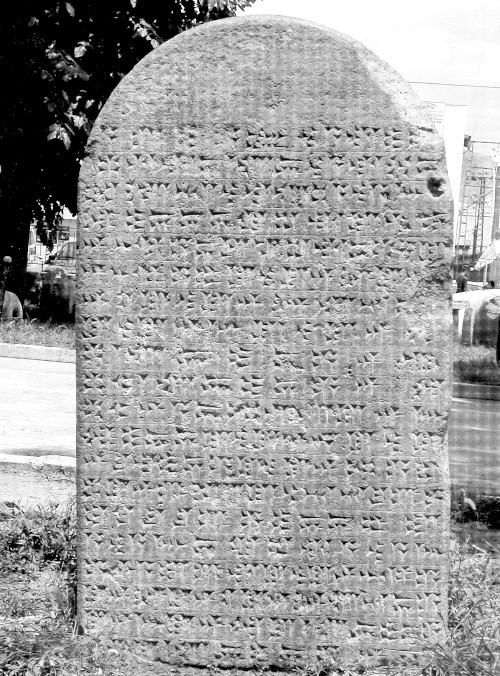Rusa, son of Erimena
Introduction
Recent studies by Ursula Seidl (2004 and 2007), Andreas Fuchs (2012), Stephan Kroll (2012), and Michael Roaf (2012) suggest that Rusa, son of Erimena, was king before Rusa, son of Argišti II. Fuchs and Roaf in particular refer to Seidl's art historical observations, which provide a sound basis for a relative chronology. However, with regard to the exact sequence of individual rulers of the first half of the 7th century, their proposals differ when ordering the reigns of Rusa, son of Erimena, Rusa, son of Sarduri, and Rusa, son of Argišti (see portal page "Introduction").

Map showing the distribution of the stone inscriptions of Rusa, son of Erimena, in: Mirjo Salvini, CTU I: 620.
Rusa, son of Erimena, contemporary of Sennacherib?
According to Seidl (2004: 124), the style of the relief bronzes of Rusa, son of Erimena, resembles the style typical for the period of the reigns of Rusa I and his predecessors, while it differs significantly from the style used during the reign of Rusa, son of Argišti. This goes along with the similarity between the royal titles of both Argišti II and Rusa, son of Erimena. According to Fuchs, Rusa, son of Erimena, was a contemporary of Sennacherib. His reign probably began in 709 BC (Fuchs 2012: 148); its end, however, is unknown.
Rusa, son of Erimena, contemporary of Sargon II?
According to Roaf (2012), Rusa, son of Erimena, was already in power when Sargon II ascended the throne in 722 BC. The first part of his reign was then dedicated to his building projects, among which Rusaḫinili and Ulḫu were most prominent. His reign came to an end in the wake of Sargon's II victory in the battle of Mount Uauš in 714 BC (see portal page "Introduction" for a discussion of the possible scenarios for Rusa II's end).
The present overview defers to Roaf's assessment and considers Rusa II to be the contemporary of Tiglath-pilesar III and Sargon II. Thus, Sargon's II inscriptions provide synchronisms and the only textual evidence for the events of the Assyrian-Urartian war.
Military activities
The theatre of war now lay in the east – the Zagros region inhabited by the Manneans. Their internal political conflicts offered both Sargon II and Rusa I the opportunity to broaden their sphere of influence. Two parties within Mannea, one pro-Urartian and one pro-Assyrian, struggled for supremacy. The pro-Urartian party, led by Bagdatti of Uišdiš and Metatti of Zikirtu, battled Aza - Sargon II's vassal – and killed him. This event eventually led to the battle of Mount Uauš, which took place between the Urartian forces and their Mannean allies and the Assyrian army in the early summer of 714 BC. Sargon II won the skirmish and thus put an end to Urartian ambitions in the region south of Lake Urmia. During his campaign, Sargon II conquered and sacked Muṣaṣir and the temple of the god Ḫaldi. He also claimed that Rusa committed suicide. Despite this, Assyrian sources mention Rusa as ally of Ambaris of Bīt Purutaš one year later in 713 BC.
Royal Titles
"(I am) Rusa, son of Erimena, mighty king, king of the Bia lands" (CTU 14-1, rev. 27-28).
Building activities
Votives of Rusa, son of Erimena, have been found only in Toprakkale/Rusaḫinili; they are completely absent in sites assigned to Rusa, son of Argišti. On the basis of this, Seidl has suggested that Toprakkale was founded by Rusa, son of Erimena, rather than by Rusa, son of Argišti, as Salvini had proposed referring to CB Ba-6 (CTU IV, pl. 198) – a clay bulla – which conveys that Rusa, son of Argišti, set up a throne in Toprakkale/Rusaḫinili during his accession year. Fuchs (2013) subsequently argued that the site must have already existed as Rusa, son of Argišti's coronation took place there (Fuchs 2013: 147). This is supported by the stele of Keşiş Göl (A 14-01), which reports on the agricultural development of the region Toprakkale/Rusaḫinili. The site's name was later supplemented by the addition of "Qilbanikai", i.e. "vis-à-vis Mount Qilbani". This occurred during the reign of Rusa, son of Argišti, who built another fortress-residence known by the name "Rusaḫinili Eiduru-kai", i.e. " Rusaḫinili vis-à-vis Mount Eiduru" (A 12-09 ll.1-3).
Agricultural infrastructure and irrigation systems
In inscriptions A 14-01 and A 14-02, Rusa, son of Erimena, stated that the land "in front of Mount Qilbani" was undeveloped. In order to cultivate the region, he built a lake named "Lake of Rusa," fed by "the water of the mighty mountainous land," as well as a canal to service his new foundation of Rusaḫinili. In addition, he planted vineyards, woods, and fields of grain.

Upper part of the stele from Gövelek with the inscription A 14-1, in: Mirjo Salvini, CTU III: 369.

Reconstruction by A. Mancini of the Keşiş Göl stele with the two fragments A 14-1 and A 14-2, in: Mirjo Salvini, CTU III: 379.
Religious activities
According to inscriptions A 14-01 and A 14-02, Rusa, son of Erimena, established a ritual connected to the "Lake of Rusa".
Grain supply
Rusa, son of Erimena, states in his inscriptions A 14-05 and 06 that he filled the silos of two sites, i.e. Erin-berd (A 14-06) and a site so far unknown, with grain (A 14-05). Similar texts are known for Minua, Argišti I and Sarduri (see the respective portal pages).
Inscriptions on metal objects
Bronze objects were found in Toprakkale (B 12-1 to B 12-14), all of which were votive offerings for the god Ḫaldi.
Further reading
Birgit Christiansen
Birgit Christiansen, 'Rusa, son of Erimena', Electronic Corpus of Urartian Texts (eCUT) Project, The eCUT Project, a sub-project of MOCCI, 2021 [http://oracc.museum.upenn.edu/ecut/urartianrulersandtheirinscriptions/rusasonoferimenaa14andb14/]